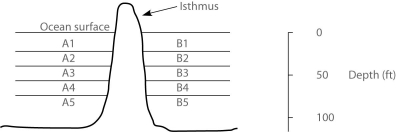The next few questions refer to the following description.
In the ocean, on either side of the Isthmus of Panama, are 30 species of snapping shrimp; some are shallow-water species, others are adapted to deep water. There are 15 species on the Pacific side and 15 different species on the Atlantic side. The Isthmus of Panama started rising about 10 million years ago.
In the following figure, the isthmus separates the Pacific Ocean on the left (side A) from the Atlantic Ocean on the right (side B) . The seawater on either side of the isthmus is separated into five depth habitats (1-5) , with 1 being the shallowest.

-Which of these habitats is likely to harbor the youngest species?
Definitions:
Q6: Adaptive radiation<br>A) reduces the size of prosperous
Q8: Test tube 4 contains<br>A) Paramecium.<br>B) Navicula (diatom).<br>C)
Q18: The adaptive advantage associated with the filamentous
Q24: What is an example of what happens
Q41: Whatever its ultimate cause(s), the Cambrian explosion
Q44: In the United States, the parasite that
Q46: Evolution<br>A) must happen, due to organisms' innate
Q93: An ionic bond is formed by<br>A) sharing
Q95: Argon has atomic number 18. Which of
Q112: Adaptations in plants to life on land